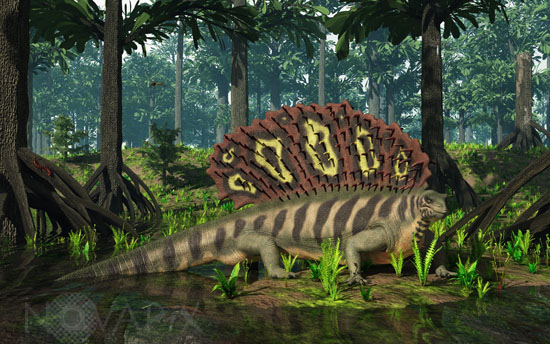Photo Agency - Astronomy - Space - Nature

Edaphosaurus amidst cordaites
author: Walter B. Myers/Novapix
reference: t-din00-20007
Image Size 300 DPI: 42 * 26 cm
A ten-foot-long, 600 pound synapsid of the genus Edaphosaurus forages in a brackish mangrove-like swamp of gymnosperms of the genus Cordaites 300 million years ago in what is today Western Europe.
Like its better-known synapsid cousin Dimetrodon, Edaphosaurus had a large sail on its back supported by elongated neural spines, however unlike Dimetrodon, these spines include numerous short cross bars; while the sail may have served the purpose of both helping to regulate body temperature and as sexual display, the purpose of the cross bars is unknown. Jaw and teeth structure suggests that Edaphosaurus probably dined on both plants and small invertebrates, such as mollusks.
Tree-like Cordaites, now extinct, grew on wet ground similar to the Everglades in Florida, numerous fossils of which are now found associated with coal deposits. Also in this image are several examples of extinct seed fern of the genus Neuropteris as well as smaller examples of generic fern that may have been present during the period.
Other fauna include two examples of the large dragonfly-like Meganeura, a centipede, and in the foreground a juvenile prehistoric shark of the genus Xenaca.
Keywords for this photo:
2012 - ANIMAL - EARTH - EDAPHOSAURUS - FAUNA - HISTORY OF EARTH - ILLUSTRATION - PALEOZOIC - PERMIAN - SYNAPSID -
Contact : Stéphane Aubin +33-(0)9-51-26-53-76
© Novapix - All rights reserved


